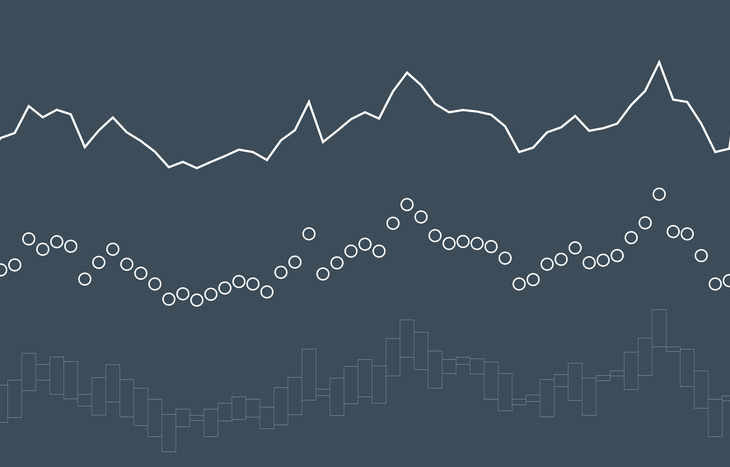Three Types of Forex Chart Patterns
As you begin to get familiar with technical analysis, you’ll start to see three distinct types of forex chart patterns emerge. While you might be looking for wedges, flags, channels and triangles, the context of these patterns groups them into one of three families: reversal, continuation or bilateral patterns.
These three types of chart patterns dictate how traders can expect the pattern to behave and how the price of a security will respond as the pattern culminates. If you know a pattern is a reversal formation as opposed to a continuation one, it’ll influence whether you take out a short or long position. This is the most fundamental decision any trader needs to make before they even think about setting price targets or stop-losses.
Let’s look at what makes each of these three forex chart patterns unique. Also, as will become evident below, wedges can signal either reversal or continuation, depending on how they form.

Reversal Chart Patterns
Reversal chart patterns are the most common forex chart patterns and the easiest for beginners to spot. They signal that an uptrend or downtrend will soon come to an end, with a breakout in price in the opposite direction. Some of the most common reversal chart patterns include:
- Double Tops and Bottoms
- Head and Shoulders
- Wedges
Reversal chart patterns can be either bearish or bullish. For example, a head and shoulders pattern beginning with an uptrend will ultimately end in a massive fall when it breaks the neckline. Conversely, a descending wedge with narrowing volume is likely on the cusp of an uptrend breakout.
To trade these patterns, traders need to correctly identify the direction of the trend and establish support and resistance levels to see where the breakout will occur. Once they identify the culmination point of the pattern, it’s best to target a position just after it breaks the support or resistance level. And set a target price that’s roughly the same high or low as the formation.
Continuation Chart Patterns
As their name implies, continuation patterns signal the continuation of a pricing trend. They’re often also referred to as “consolidation patterns” because they show reduced trading volume as part of their formation. Some common continuation chart patterns include:
- Channels and Rectangles
- Pennants
- Wedges
These patterns tend to represent a “breather” from rising or falling price action. Trading volumes slow down as the pattern consolidates, with less distance between support and resistance levels. Once traders establish their positions, the price continues on its trend. Bullish continuation patterns show continued confidence in the value of the security. Bearish trends indicate an overpriced security.
To trade continuation patterns, traders need to look at volume. Watch for volume to slow considerably before breaking out in the same direction as the formation. It’s usually a good idea to open a position as volume shows signs of increasing and as the pattern breaks the support or resistance slope. Place a price target equivalent to the height of the formation.
Bilateral Chart Patterns
When a pattern doesn’t signal continuation or reversal—or when it could result in either—it’s considered a bilateral chart pattern. This group almost exclusively belongs to triangles. However, some channels are bilateral. This is also different from wedges, which have more specific markers during their formation. Triangles are the true wildcards.
Bilateral patterns indicate mixed sentiment about the price of a security. Particularly as support and resistance levels narrow. Investors are prone to doubling down or changing course, depending on a number of factors. For example, in hindsight, continuation triangles form the “breather” in a continuation pattern, with lower volume. Conversely, the triangle might end up as a chance for profit-taking, causing reversal at the breakout.
Price breaks can occur up or down as triangles come to a point, which means traders need to prepare for movement in either direction. The best way to do this is to hedge, with both short and long positions. Just make sure not to set your orders too close to the pattern or a false break could trigger them prematurely.
Patterns Are Trends, Not Sureties
The takeaway from these three pattern families is that trends are expected, not guaranteed. Technical traders use trends as a baseline for predictions about how a stock will reasonably behave as the pattern culminates. If you know a head and shoulders pattern is reliable X% of the time, you can trade that pattern with relative certainty.
False patterns, premature action and market abnormalities will all affect patterns and can lead to unanticipated outcomes. To protect against them, traders should always act on a trend with confidence. However, set up safeguards to protect you against the unexpected. This includes setting stop-losses.
Finally, thorough technical analysis can add even more credence to pattern trading. Forex chart patterns have basis in the actions and behaviors of investors. Understanding why a pattern forms and the meaning behind that pattern lends even more confidence to trades with or against it. Good technical analysis can even help traders spot and avoid false patterns – for example, if trade volume doesn’t match up with market sentiment or if trailing averages skew investor risk tolerance.
Using indicators is a great way to build wealth through the stock market. For the latest wealth building strategies, sign up for the Liberty Through Wealth e-letter below.
As you trade forex chart patterns and become adept at recognizing them, pay attention to whether they’re reversal, continuation or bilateral. This fundamental understanding can serve as the basis for entire trading strategies.





